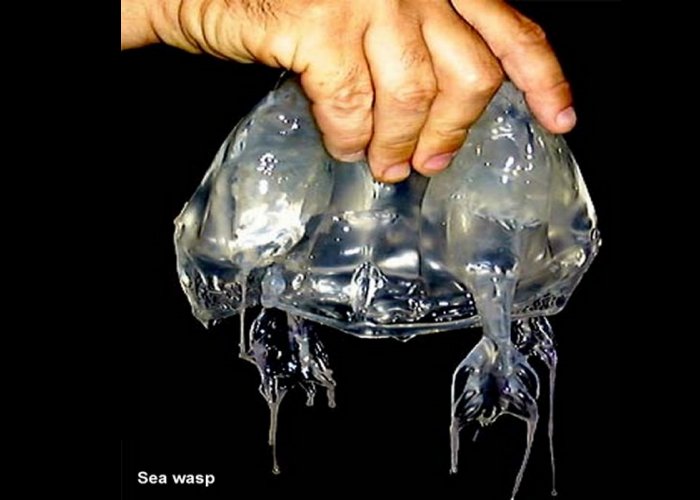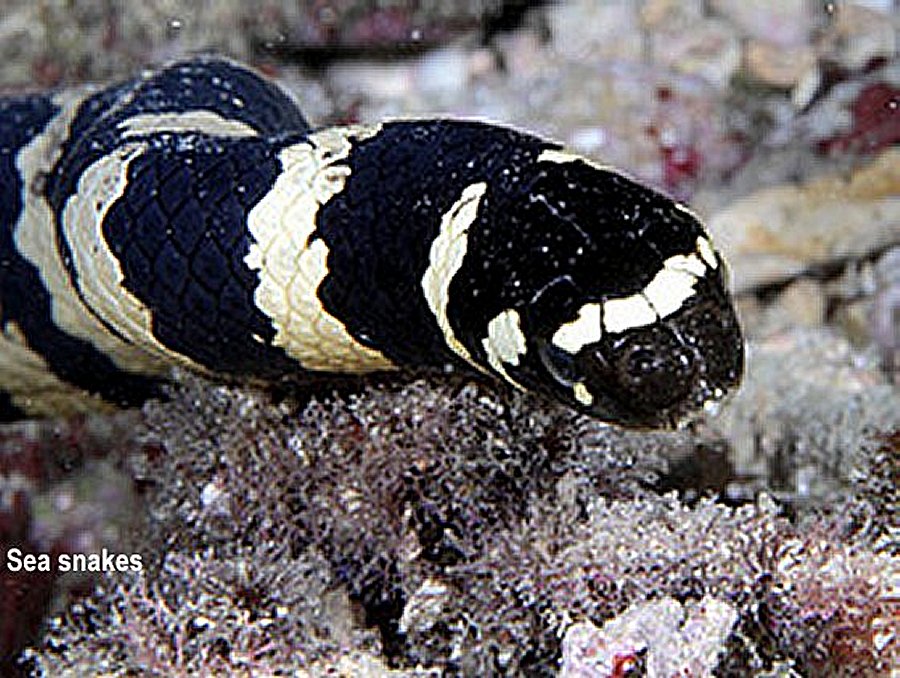Marine Creatures You’d Better Stay Away From
MessageToEagle.com – While exploring more exotic underwater realms, one should keep in mind that some of marine creatures are very dangerous.
Bites from sea wasp, or marine stinger from Northern Australia, for example, require professional, medical treatment and application of the antidote.

Be careful while being in its vicinity. It grows to about the size of a human head, has tentacles up to three meters long and four eyes!
It has one of the fastest working toxins and kills more people each year than any other marine animal. Poisonous fluid secreted by a single sea wasp can kill up to 60 adults!
Over 100 people have been killed by the stings from a Chironex fleckeri and many more have been stung, but survived. Get stung badly enough by one and you could be dead within four minutes.
The real danger comes when they sense the presence of certain chemicals and not by touch. This means that you could touch this creature without being stung if your skin didn’t release these chemicals.
Once activated by the right chemicals, e.g. chemicals exuded by human skin or fish scales, the stinger cells immediately inject their venom into the victim.
Stonefish may be found from exposed sand and mud in tidal inlets to depths of 40 m. Lying on the sea bed, it is perfectly camouflaged and looks exactly like an encrusted rock.
They say, this is the deadliest fish in the world. This marine creature reaches up to 35 cm in length and lives in the Indo-Pacific region and northern Australian waters.
Its “face” is not particularly sympathetic!
It’s a brownish colour, and often resembles a rock. This is why it is called the Stonefish. It has thirteen sharp dorsal spines on its back, which each have extremely poisonous fluid.
The sting causes excruciating pain and a great deal of swelling rapidly develops causing death to tissues. The severity of the symptoms depends on the depth of penetration and the number of spines penetrated. The symptoms of the venom are muscle weakness, temporary paralysis and shock, which may result in death if not treated.
First Aid regarding Stone Fish Venom : Do not attempt to restrict the movement of the injected toxin.
A bite from a blue-ringed octopus can completely paralyze and kill an adult human in a matter of minutes. There is no known antidote. The octopus itself is not affected at all by the toxin.
It is most active after dark, and spends most of its day hidden in its nest. Like all octopods, the blue-ringed octopus has no skeleton and is thus very flexible and maneuverable.
It can squeeze into tiny crevices and make dens in bottles, aluminum cans, or mollusk shells. The blue-ringed octopus is also known to burrow into sand or gravel to conceal itself.
They are beautiful marine creatures “at risk of extinction”! Respect them! Don’t irritate and rather avoid! Sea snakes can be dangerous because their venom is more toxic than that of land snakes but it’s reserved for quickly immobilising prey, not for defence.
Usually they stay away from people, biting only when provoked. Provoked snakes can become very aggressive and persistent.
Persistent myths about sea snakes include the mistaken idea that they can’t bite very effectively. The truth is that their short fangs (2.5-4.5mm) are adequate to penetrate the skin, and they can open their small mouths wide enough to bite a table top.
It is said that even a small snake can bite a man’s thigh. Sea snakes can swallow a fish that is more than twice the diameter of their neck. Intense pain caused by the creature’s bite comes approximately 30 minutes later. There is stiffness, muscle aches and spasm of the jaw followed by moderate to severe pain in the affected limb.
There follows progressive symptoms of blurred vision, drowsiness and finally respiratory paralysis. A specific antivenin is available and necessary.
Sharks rarely target people as prey and when a shark does injure a human, it is often because it has mistaken that person for a seal, a sea lion or one of its usual prey animals!
They are more in need of protection from us than we are from them. That said, it is also true that some species of shark are more prone to attacking humans than others, scientists say.
“…over half of all lethal attacks on humans over the centuries have come from just three species of sharks: the great white shark (Carcharodon carcharias), the tiger shark (Galeocerdo cuvier) and the bull shark (Carcharinus leucas).
Of these “Big Three” species, the largest of them, the great white shark, is by far the most dangerous, as it has been responsible for more unprovoked attacks and deaths than the other two species put together.
The great white occupies the top slot on the list of ten most dangerous sharks, with the tiger shark coming in a distant second.
NOT ALL creatures of underwater realms are dangerous, but they are mysterious because we don’t know anything about them.
Their name is oarfish. They are seen hanging vertically like a pipe in the water column. Most often ,they have been discovered swimming at or near the surface where they are dying, or dead. It’s very difficult to see this creature alive. They do seem to come out of the sunless depths only… to die, someone once wrote. Growing up to 17 meters long, the oarfish is currently the largest known bony fish with slender body that gives it a snake-like appearance.
This mysterious creature could account for many ancient legends and myths of giant sea serpents.
Copyright © MessageToEagle.com All rights reserved. This material may not be published, broadcast, rewritten or redistributed in whole or part without the express written permission of MessageToEagle.com
Related Posts
-
 René Descartes’ Evil Demon Argument – Can Our Senses Deceive Us?
No Comments | Feb 18, 2019
René Descartes’ Evil Demon Argument – Can Our Senses Deceive Us?
No Comments | Feb 18, 2019 -
 We Live In A Virtual World Inside Our Heads – Says Steve Grand, Author Of “Creation: Life And How To Make It”
No Comments | Nov 3, 2015
We Live In A Virtual World Inside Our Heads – Says Steve Grand, Author Of “Creation: Life And How To Make It”
No Comments | Nov 3, 2015 -
 Triassic Specimen Found To Be Early Relative Of Pterosaurs A Century After Its Discovery
No Comments | Oct 10, 2022
Triassic Specimen Found To Be Early Relative Of Pterosaurs A Century After Its Discovery
No Comments | Oct 10, 2022 -
 World’s Longest Underground River Flows Beneath The Yucatán Peninsula
No Comments | Jan 16, 2016
World’s Longest Underground River Flows Beneath The Yucatán Peninsula
No Comments | Jan 16, 2016 -
 Did The Ancient Trojan Horse Really Exist?
No Comments | Aug 19, 2015
Did The Ancient Trojan Horse Really Exist?
No Comments | Aug 19, 2015 -
 Pirahã: Weird Language That Lacks Words For Numbers And Colors
No Comments | Jan 31, 2017
Pirahã: Weird Language That Lacks Words For Numbers And Colors
No Comments | Jan 31, 2017 -
 Triceratops Teamed Up: Research Shows That Five Three-Horned Dinosaurs Lived And Died Together
No Comments | Mar 28, 2024
Triceratops Teamed Up: Research Shows That Five Three-Horned Dinosaurs Lived And Died Together
No Comments | Mar 28, 2024 -
 Is Death A Dream Or Illusion?
No Comments | Mar 29, 2015
Is Death A Dream Or Illusion?
No Comments | Mar 29, 2015 -
 Mythical Fiery Bird Phoenix In Mythologies Of Many Ancient Cultures
No Comments | Mar 23, 2017
Mythical Fiery Bird Phoenix In Mythologies Of Many Ancient Cultures
No Comments | Mar 23, 2017 -
 Modern Snakes Evolved From A Few Survivors Of Dino-Killing Asteroid
No Comments | Sep 15, 2021
Modern Snakes Evolved From A Few Survivors Of Dino-Killing Asteroid
No Comments | Sep 15, 2021




